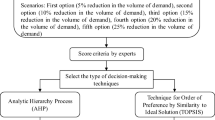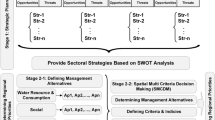Abstract
Considering the multidimensionality of water resources management policies and prioritization of water demands, engineering software have attracted researchers and planners. The Water Evaluation and Planning (WEAP) program (Multi-Attribute Decision Analysis Model) is one of the specialized software that uses the Water Algorithm Equation and is used for water resources planning and management at the watershed level. In order to forecast future water resources, runoff for the years to come by 2100 was first simulated using WEAP along a new climate prediction model (CMIP5) and a rainfall-runoff model. Then, the amount of drinking water and industry needs and net irrigation requirement were calculated by 2100. Results showed that by applying the climate prediction model and considering the effect of human factors on water resources and applying adaptive correction scenarios for the years to come, allocation of water resources in the Zayandeh Rud area was used to predict the status of water resources for planning. Considering the WEAP model for optimal water allocation, it can be admitted that agricultural demand can be met with 60% confidence and drinking water and the industry requirements can be met with 83% confidence.












Similar content being viewed by others
References
Adebola AO, Ibrahim AH, Wigeti WH, Yaro NA (2018) Drainage basin morphology and terrain analysis of the lower Benue River Basin, Nigeria. SCI World J 13(1):18–22
Altieri MA, Nicholls CI (2017) The adaptation and mitigation potential of traditional agriculture in a changing climate. Clim Chang 140:33–45. https://doi.org/10.1007/s10584-013-0909-y
Al-Zubari WK, El-Sadek AA, Al-Aradi MJ, Al-Mahal HA (2018) Impacts of climate change on the municipal water management system in the Kingdom of Bahrain: vulnerability assessment and adaptation options. CLIM Risk Manage 20:95–110. https://doi.org/10.1016/j.crm.2018.02.002
Amacha N, Karam F, Jerdi M, Frank P, Viala E (2017) Assessment of the efficiency of a pilot constructed wetland on the remediation of water quality: case study of Litani River, Lebanon. Environ Pollut CLIM Change 1:119
Amin A, Iqbal J, Asghar A, Ribbe L (2018) Analysis of current and future water demands in the upper Indus Basin under IPCC climate and socio-economic scenarios using a hydro-economic WEAP model. Water 10:537. https://doi.org/10.3390/w10050537
Amjath-Babu TS, Sharma B, Brouwer R, Rasul G, Wahid SM, Neupane N, Bhattarai U, Sieber S (2019) Integrated modelling of the impacts of hydropower projects on the water-food-energy nexus in a transboundary Himalayan river basin. Appl Energy 239:494–503
Anand J, Gosain AK, Khosa R, Srinivasan R (2018) Regional scale hydrologic modeling for prediction of water balance, analysis of trends in streamflow and variations in streamflow: the case study of the Ganga River basin. J Hydrol Reg Stud 16:32–53. https://doi.org/10.1016/j.ejrh.2018.02.007
Ashofteh PS, Bozorg-Haddad O, Loáiciga HA (2017) Development of adaptive strategies for irrigation water demand management under climate change. J Irrig Drain Eng 143:04016077–04016077. https://doi.org/10.1061/(ASCE)IR.1943-4774.0001123
Azari A, Asadi M (2017) Investigating the capabilities of the NSGA-II multi-objective algorithm in automatic calibration of the WEAP model for simulating Jareh Dam and network system. J Appl Res Water Wastewater 4:305–313. https://doi.org/10.22126/arww.2017.775
Basco-Carrera L, van Beek E, Jonoski A, Benítez-Ávila C, Guntoro FXPJ (2017) Collaborative modelling for informed decision making and inclusive water development. Wat Res Manag 31:2611–2625. https://doi.org/10.1007/s11269-017-1647-0
Das B, Singh A, Panda SN, Yasuda H (2015) Optimal land and water resources allocation policies for sustainable irrigated agriculture. Land Use Policy 42:527–537. https://doi.org/10.1016/j.landusepol.2014.09.012
Dehghan Z, Delbari M, Mohammad RPO (2015) Planning water resources allocation under various managerial scenarios in Gorganroud Basin. Wat Soil Sci 25:117–132 http://www.sid.ir/En/Journal/ViewPaper.aspx?ID=506270
Digna RF, Mohamed YA, van der Zaag P, Uhlenbrook S (2018) Impact of water resources development on water availability for hydropower production and irrigated agriculture of the Eastern Nile Basin. J Water Resour Plan Manag 144:05018007–05018007. https://doi.org/10.1061/(ASCE)WR.1943-5452.0000912
Dubinsky J, Karunanithi AT (2017) Consumptive water use analysis of upper Rio Grande Basin in Southern Colorado. Environ Sci Technol 51:4452–4460. https://doi.org/10.1021/acs.est.6b01711
Elsawah S, Pierce SA, Hamilton SH, van Delden H, Haase D (2017) An overview of the system dynamics process for integrated modelling of socio-ecological systems: lessons on good modelling practice from five case studies. Environ Model Softw 93:127–145. https://doi.org/10.1016/j.envsoft.2017.03.001
Fisher JB, Melton F, Middleton E, Hain C, Anderson M (2017) The future of evapotranspiration: global requirements for ecosystem functioning, carbon and climate feedbacks, agricultural management and water resources. Water Resour Res 53:2618–2626. https://doi.org/10.1002/2016WR020175
Green PA, Vörösmarty CJ, Harrison I, Farrell T, Sáenz L (2015) Freshwater ecosystem services supporting humans: pivoting from water crisis to water solutions. Glob Environ Chang 34:108–118. https://doi.org/10.1016/j.gloenvcha.2015.06.007
Hellegers P, Immerzeel W, Droogers P (2013) Economic concepts to address future water supply–demand imbalances in Iran, Morocco and Saudi Arabia. J Hydrol 502:62–67. https://doi.org/10.1016/j.jhydrol.2013.08.024
Javadinejad S (2016) Vulnerability of water resources under climate change and human impacts: scenario analysis in the Zayandeh rud river basin. PhD Thesis, University of Birmingham, UK
Keraga AS, Kiflie Z, Engida AN (2017) Spatial and temporal water quality dynamics of Awash River using multivariate statistical techniques. Afr J Environ Sci Technol 11:565–577. https://doi.org/10.5897/AJEST2017.2353
Kerzner H, Kerzner HR (2017) Project management: a systems approach to planning, scheduling and controlling, 1st edn. John Wiley and Sons, New Jersey, ISBN-10: 1119165350, p 848
Khatib M, Obando JY, Murimi S (2018) Effects of irrigation management practices on water allocation among farmers in Kiladeda sub-catchment, Tanzania. In: Ondieki CM, Kitheka JU (eds) Hydrology and best practices for managing water resources in arid and semi-arid lands. IGI Global, Hershey, ISBN-10: 1522527206, pp 70–86
Kishiwa P, Nobert J, Kongo V, Ndomba P (2018) Assessment of impacts of climate change on surface water availability using coupled SWAT and WEAP models: case of upper Pangani River Basin, Tanzania. Proc IAHS 378:23–27. https://doi.org/10.5194/piahs-378-23-2018
Koohiyan AF, Yakhleshi ME, Shafaeianfard D (2014) Determination of top options in utilization of water resources using WEAP model and multi attribute decision-making analysis (case study: Zaryngol basin). J Watershed Manage Res 5:29–45 http://www.sid.ir/En/Journal/ViewPaper.aspx?ID=416191
Kotir JH, Smith C, Brown G, Marshall N, Johnstone R (2016) A system dynamics simulation model for sustainable water resources management and agricultural development in the Volta River Basin, Ghana. Sci Total Environ 573:444–457. https://doi.org/10.1016/j.scitotenv.2016.08.081
Kuhn A, Britz W, Willy DK, van Oel P (2016) Simulating the viability of water institutions under volatile rainfall conditions—the case of the Lake Naivasha Basin. Environ Model Softw 75:373–387. https://doi.org/10.1016/j.envsoft.2014.08.021
Kumar P, Masago Y, Mishra BK, Fukushi K (2018) Evaluating future stress due to combined effect of climate change and rapid urbanization for Pasig-Marikina River, Manila. Groundwater Sustain Dev 6:227–234. https://doi.org/10.1016/j.gsd.2018.01.004
Li X, Zhao Y, Shi C, Sha J, Wang ZL (2015) Application of Water Evaluation and Planning (WEAP) model for water resources management strategy estimation in coastal Binhai New Area, China. Ocean Coast Manag 106:97–109. https://doi.org/10.1016/j.ocecoaman.2015.01.016
Maknoon R, Kazem M, Hasanzadeh M (2012) Inter-basin water transfer projects and climate change: the role of allocation protocols in economic efficiency of the project. Case study: Dez to Qomrood inter-basin water transmission project (Iran). J Water Resour Prot 4:750–758. https://doi.org/10.4236/jwarp.2012.49085
Mansouri S, Ouerdachi L, Remaoun M (2017) Inter-region planning and analysis of water resources by using WEAP model Seybouse (Annaba) and coastal east of Constantine (El-Taref). J Water Land Dev 33:115–122. https://doi.org/10.1515/jwld-2017-0026
Metobwa OGM, Mourad KA, Ribbe L (2018) Water demand simulation using WEAP 21: a case study of the Mara River Basin, Kenya. Int J Nat Resour Ecol Manag 3:9–18. https://doi.org/10.11648/j.ijnrem.20180301.1
MYCE (2016) Water resources and water demands for urban and rural society with considering of integrated watershed management in Gavkhooni, Siyahkooh and Rig-zarin catchments, chapter one to seven, Tehran, Iran. Moshaver Yekom Consulting Engineers
Paparrizos S, Maris F (2017) Hydrological simulation of Sperchios River basin in Central Greece using the MIKE SHE model and geographic information systems. Appl Water Sci 7:591–599. https://doi.org/10.1007/s13201-015-0271-5
Percival RV, Schroeder CH, Miller AS, Leape JP (2017) Environmental Regulation: Law, Science and Policy, 1st edn. Wolters Kluwer Law and Business, New York, ISBN-10: 1454882115, p 1456
Pham BQ, Yub PS, Yang TC, Tseng HW (2015) Assessment of climate change impacts on hydrological processes and water resources by Water Evaluation and Planning (WEAP) model: case study in THAC mo catchment, VIETNAM. Proceedings of the 37th IAHR World Congress, Aug. 13–18, Kuala Lumpur, Malaysia, pp 4312–4321. https://www.researchgate.net/publication/318671823_ASSESSMENT_OF_CLIMATE_CHANGE_IMPACTS_ON_HYDROLOGICAL_PROCESSES_AND_WATER_RESOURCES_BY_WATER_EVALUATION_AND_PLANNING_WEAP_MODEL_CASE_STUDY_IN_THAC_MO_CATCHMENT_VIETNAM
Playán E, Salvador R, Bonet L, Camacho E, Intrigliolo DS (2018) Assessing telemetry and remote control systems for water users associations in Spain. Agric Wat Manag 202:89–98. https://doi.org/10.1016/j.agwat.2018.02.015
Sandoval-Solis S, McKinney DC, Teasley RL, Patino-Gomez C (2010) Groundwater banking in the Rio Grande basin. J Wat Resour Plann Manag 137:62–71. https://doi.org/10.1061/(ASCE)WR.1943-5452.0000091
Simonovic SP (2015) Water resources systems analysis through case studies: data and models for decision making. Can Water Resour J 40:232–233. https://doi.org/10.1080/07011784.2014.998290
Singh, M., 2018. Development of integrated water resources management plan for a basin using Water Evaluation and Planning (WEAP) Model. Diss. IIT, Kharagpur
Slaughter AR, Mantel SK (2018) Water quality modelling of an impacted semi-arid catchment using flow data from the WEAP model. Proceed IAHS 377:25–33. https://doi.org/10.5194/piahs-377-25-2018
Suryadi Y, Chrysanti A, Nurnadiati F, Adityawan MB, Kuntoro AA (2018) Study on water resources allocation for kertajati, Jatitujuh and Ligung sub-districts to support the development of west java international airport (BIJB) and kertajati aerocity area. In: Proceedings of the 3rd International Conference on Sustainable Infrastructure and Built Environment, (IBE’ 18). https://doi.org/10.1051/matecconf/201814703010
Tejero R, Gomez-Ortiz D, Heydt GG, Toledo FM, Martínez CMC (2017) Electrical resistivity imaging of the shallow structures of an intraplate basin: the Guadiana Basin (SW Spain). J Appl Geophys 139:54–64. https://doi.org/10.1016/j.jappgeo.2017.02.007
Thiam DR, Muchapondwa E, Kirsten J, Bourblanc M (2015) Implications of water policy reforms for agricultural productivity in South Africa: scenario analysis based on the Olifants river basin. Water Resour Econ 9:60–79. https://doi.org/10.1016/j.wre.2014.11.001
Tian Y, Zheng Y, Wu B, Wu X, Liu J (2015) Modeling surface water-groundwater interaction in arid and semi-arid regions with intensive agriculture. Environ Model Softw 63:170–184. https://doi.org/10.1016/j.envsoft.2014.10.011
Tizro AT, Voudouris K, Mattas C, Kamali M, Rabanifar M (2018) Evaluation of irrigation efficiency effect on groundwater level variation by Modflow and WEAP models: a case study from Tuyserkan Plain, Hamedan, Iran. In: Mattas K, Baourakis G, Zopounidis C (eds) Sustainable agriculture and food security: aspects of euro-Mediteranean business cooperation. Springer, Cham, pp 121–141
Vaghefi SA, Mousavi SJ, Abbaspour KC, Srinivasan R, Arnold JR (2015) Integration of hydrologic and water allocation models in basin-scale water resources management considering crop pattern and climate change: Karkheh River Basin in Iran. Reg Environ Chang 15:475–484. https://doi.org/10.1007/s10113-013-0573-9
Wang XJ, Zhang JY, Shamsuddin S, Oyang RL, Guan TS (2017) Impacts of climate variability and changes on domestic water use in the Yellow River Basin of China. Mitig Adapt Strat Glob Chang 22:595–608. https://doi.org/10.1007/s11027-015-9689-1
Wu B, Zheng Y, Wu X, Tian Y, Han F (2015) Optimizing water resources management in large river basins with integrated surface water-groundwater modeling: a surrogate-based approach. Water Resour Res 51:2153–2173. https://doi.org/10.1002/2014WR016653
Yaykiran S, Cuceloglu G, Ekdal A (2019) Estimation of water budget components of the Sakarya River Basin by using the WEAP-PGM model. Water 11(2):271
Author information
Authors and Affiliations
Corresponding author
Additional information
Publisher’s Note
Springer Nature remains neutral with regard to jurisdictional claims in published maps and institutional affiliations.
Rights and permissions
About this article
Cite this article
Javadinejad, S., Ostad-Ali-Askari, K. & Eslamian, S. Application of Multi-Index Decision Analysis to Management Scenarios Considering Climate Change Prediction in the Zayandeh Rud River Basin. Water Conserv Sci Eng 4, 53–70 (2019). https://doi.org/10.1007/s41101-019-00068-3
Received:
Revised:
Accepted:
Published:
Issue Date:
DOI: https://doi.org/10.1007/s41101-019-00068-3




